A pressure washer can be turned into a sewer jetter, hydro jetter, or water jetter by attaching a nozzle that is specifically designed to clean sewer lines and drains. How to convert a pressure washer into a sewer jetter is discussed in detail below.
How Does a Sewer Jetter Work?
A sewer jetter removes sludge, grease, paper, hair, and tree root blockages that obstruct drain pipes by cleaning and opening the line. Sewer jetters have a long hose with a nozzle that delivers 3 to 6 super-pressurized streams of water through pipes. A sewer jetter blasts the walls of the drain pipe with pressurized water and breaks down and clears blockages.
Signs You Need a Sewer Jetter
Signs that a sewer jetter is needed are listed below:
- Expensive monthly water bills,
- Draining is slow,
- Smelly sinks,
- Gurgling noise coming from the pipes,
- No other method such as snaking or using drain cleaners removed the clog.
Can I Use a Pressure Washer as a Sewer Jetter?
Yes, a pressure washer can be used as a sewer jetter. A sewer jetter consists of a high-pressure pump and a long hose with the right nozzle. A pressure washer that has a pressure washer pump that delivers 25 GPM can be turned into a sewer jetter. A residential pressure washer can’t be turned into a sewer jetter since it doesn’t come with a powerful high-pressure pump.
How Does a Pressure Washer Compare to a Sewer Jetter?
Sewer jetters clean blockages in drainage systems and sewer pipes while pressure washers clean driveways, vehicles, fences, and furniture. Sewer jetters deliver more GPM than pressure washers, while their PSI ratings can range between 1,500 and 4,000 PSI. Sewer jetters’ hoses are longer than pressure washer hoses and are delivering water at different angles.
1. PSI and GPM Requirements
A sewer jetter pump pressurizes water between 1,500 and 4,000 PSI, similar to electric pressure washers. Sewer jetters have higher GPM ratings than pressure washers. Gas pressure washers are rated between 2 and 4 GPM while sewer jetters have GPM ratings between 4 and 30. Smaller sewer jetters start at 4 GPM and go up to 9 GPM while trailer-mounted sewer jetters are rated at 30 GPM.
Using a pressure washer and a sewer jetter attachment that delivers 1 GPM is recommended for small diameter pipes. A pressure washer of 2,000 to 4,000 PSI and a sewer jetter attachment can be used for cleaning pipes between 3 and 12 inches in diameter.
2. Hose and Nozzle Attachments
Jetter hoses are long, light, flexible, slippery, and resistant to abrasion so they can reach far down the pipe. Jetter hoses can handle pressure between 3,000 and 4,000 PSI.
The main difference between sewer jetter nozzles is in the angle of the backward-facing jet holes. The nose of the nozzle, the round ‘button’ type or the pointed ‘jet’ nose, delivers a front-facing, 0° stream of water that breaks through buildup.
The jetter is pushed through the pipe by several backward-facing holes that can be set at different angles. If the angle of the hole is between 15 and 20 degrees, the nozzle can get more penetration power but won’t clear the blockage completely. The 30 and 35-degree nozzles provide a balance between thrust and pipe wall cleaning and are used for cleaning regular clogs.
Nozzles with more than 40 degrees in jet angles are often called flushing nozzles and are most suitable for a thorough cleaning, although they lack thrusting power and are not used for cleaning pipes longer than 100 feet. Some sewer jetter nozzles have a rotating design, which gives them a greater forward thrust and facilitates removing buildups.
How to Convert a Pressure Washer Into a Sewer Jetter?
Instructions on how to convert a pressure washer into a sewer jetter are provided below:
- Connect all of the pressure washer attachments to the pressure washer, except the pressure washer gun,
- Connect one end of the high-pressure hose to the pressure washer,
- Connect one end of the ball valve to the other end of the pressure hose,
- Connect the other end of the ball valve to the jumper hose,
- Connect the other end of the jumper hose to the sewer jetter hose,
- Connect the sewer jetter nozzle to the jumper hose,
- Start the pressure washer, turn on the water supply, and insert the sewer jetter hose into the drain pipe,
- Regulate the water flow by turning the switch on the ball valve.
Kits that Convert Your Pressure Washer into a Sewer Jetter
| PRODUCT | DETAILS | ||
|---|---|---|---|
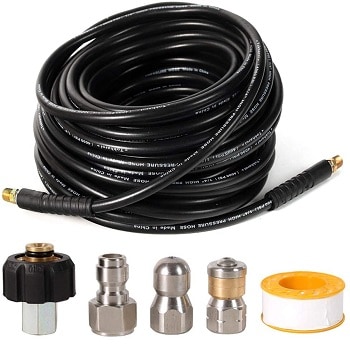 | TOKHAROI Sewer Jetter Kit |
| View On Amazon |
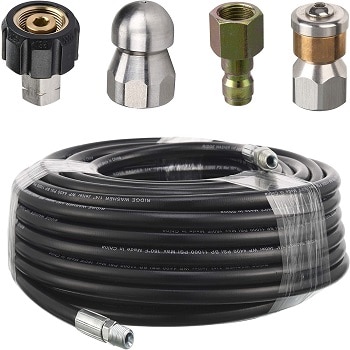 | RIDGE WASHER Sewer Jetter Kit |
| View On Amazon |
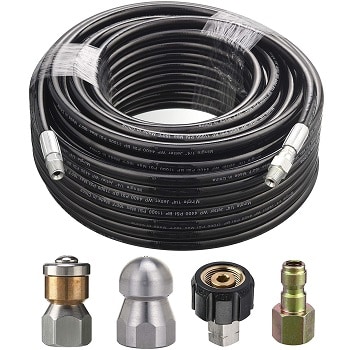 | M MINGLE Sewer Jetter Kit |
| View On Amazon |
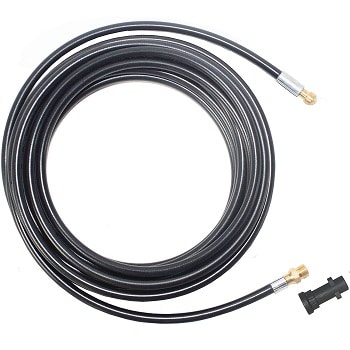 | XZT L04-K3 Sewer Drain Jetter Hose for Karcher |
| View On Amazon |
- The TOKHAROI Sewer Jetter Kit for pressure washers is designed for medium to heavy-duty tasks. This kit comes with a 100-feet long hose that can handle up to 4000 PSI and is compatible with a wide variety of pressure washer brands, such as Ryobi, Simpson, Karcher, Sun Joe, Briggs & Stratton, and more. This sewer jetter kit comes with both a button and a rotating nozzle, two plugs that connect either to a spray gun (quick connector) or a high-pressure pump directly (M22 coupler), and even a roll of seal tape.
- The RIDGE WASHER Sewer Jetter Kit comes with the same accessories as the Tokharoi kit, except for the seal tape: an M22 coupler, a quick connect pressure washer connector, a button nozzle, and a rotating nozzle as well. The hose included in this kit can handle up to 4000 PSI, and the main difference between this and the previous kit is that Ridge Washer has a 50-feet long hose.
- The M MINGLE Sewer Jetter Kit stands out among competitors because it is equipped with a 150-feet long hose, which is extremely long and offers a lot of mobility. This sewer jetter kit for pressure washers comes with a 150-feet long hose that can handle a maximum of 4000 PSI. This kit also comes with a quick connector, an M22 coupler, and both a button and a rotating nozzle.
- The XZT L04-K3 Sewer Drain Jetter Hose for Karcher is specifically made to fit the Karcher K series (models K1, K2, K3, K4, K5, K6, and K7) since these have a unique connector. The hose of this kit comes in various sizes between 25 and 85 feet, and it can handle water pressure up to 2300 PSI. This kit is equipped with a single button nozzle without a front stream.

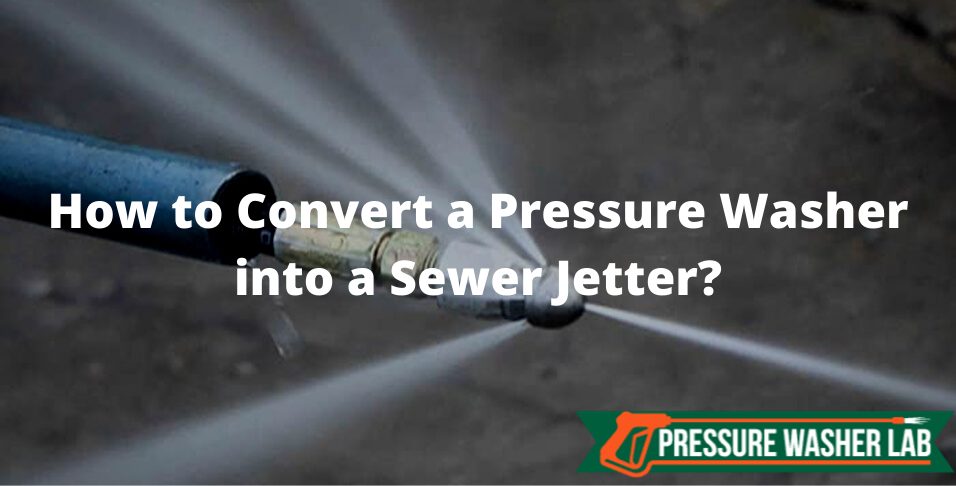
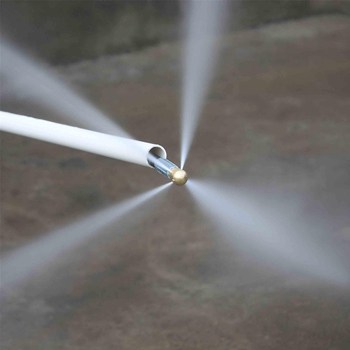
I have the 50 ft kit. What kind of power washer would be best? Do I look for 4000 psi?